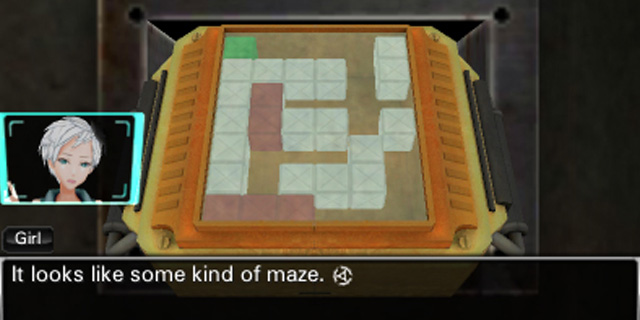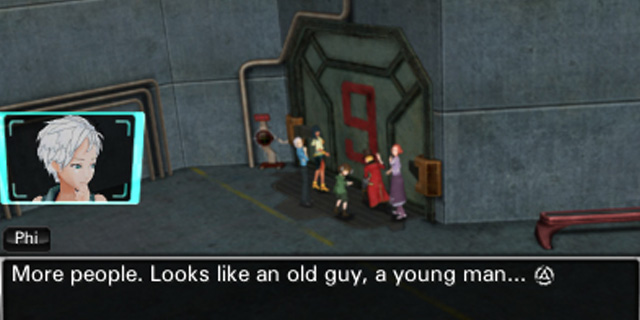
The escape-the-room visual novel 9 Hours, 9 Persons, 9 Doors (999), developed by Chunsoft and localized/published by Aksys, was a daring departure from typical DS fare when it arrived Stateside in late 2010. A mature title in both content and tone, it took any player who dared to brave its numerous walls of text on a wild ride of original story, well-developed characters, a crazy premise and puzzle-rich gaming segments. 999 quickly gained a loyal cult following and earned rave reviews from the scant handful of people who actually played it.
And somehow, against all odds and expectations by even the most ardent fan, we got a sequel.
The second title in what has been retroactively re-branded as the Zero Escape series is Virtue’s Last Reward (VLR), and like any true sequel, it features a lot of the best aspects of 999 and even a returning character or two. In fact, playing VLR without first experiencing 999 will spoil elements of the previous game’s surprise-packed narrative, so be warned. Nine characters have been brought together by a mysterious masked assailant to participate in The Nonary Game for unrevealed reasons. Throughout the strange facility in which they are trapped are a number of doors, behind which lie rooms packed with puzzles. Completing the rooms answers some questions while bringing up even more. Which door you choose to pass through with which partners will alter how the story you experience plays out, but unlike 999 that’s not the only choice that will affect you this time.

This version of The Nonary Game is called the “Ambidex Edition” by the virtual rabbit A.I. avatar that introduces itself as Zero III. This is due to the Ambidex (AB) Games that get played after each round of doors. Based on the famous “Prisoner’s Dilemma”, these AB games pit groups of the players against each other in the hopes of earning Bracelet Points (BP). Each player starts with 3 BP, and it takes 9 BP to open the Number Nine Door, which is the only way out, only open for nine seconds and only able to be opened once. If both parties in the AB game choose to ally, they each earn 2 BP. But if one side opts to betray, they could earn 3 BP while costing their allying opponents 2 BP each. The catch? If both sides betray, neither one earns (or loses) anything.
Now obviously in an ideal circumstance, all players would simply ally every time, allowing everyone to escape after three rounds. But the Nonary Game is anything but ideal circumstances, and the allure of getting out after only two rounds (leaving everyone else behind) can be too tempting to resist. There are a couple of other complications as well, both in the rules and in surprise developments, but I’ll leave them for you to discover as the characters do. The bottom line is: can you trust complete strangers to act in the best interests of the group? Or should you expect them to act in their own best interests and plan accordingly, even though a circle of mutual betrayal benefits nobody?
One of 999‘s gimmicks was that it was impossible to complete with your first playthrough, due to reasons that are eventually explained in the story. VLR takes that aspect and amplifies it about three-fold. Where 999 had five endings (plus one “to be continued” that eventually led to the true ending), VLR has nine actual endings, at least as many dead ends and several “locks” along the way that require you to make different choices somewhere along the way. Fortunately (and unlike 999), you don’t have to start over from the beginning every time. Instead you instead have access to a flowchart that maps out every possible branch point, listing novel sections, escape sections, and other useful information. You can hop to any one of these nodes at will, very similar to how Radiant Historia worked, hopping back and forth to learn more about your situation and how to get yourself out of it.

Having to replay 999 over and over was made more palatable by the ability to fast-forward through text you have already seen, and VLR upgrades that idea from a button you had to hold down constantly to a single button toggle that will automatically revert to “stop” mode when you encounter something new. VLR also takes some of the strain off your eyes by having nearly the entire novel portions of the game fully and awesomely voice-acted by top-shelf anime-dubbing talent that really brings the already brilliant writing to life. Only the main character’s dialogue (external and internal) and some expository segments of various endings are strictly text. When “skip” mode is not available, you can toggle on “auto” mode that will naturally advance the dialog to maintain a smooth flow, although there might be a slight delay if you read faster than the generous time it allows for the non-spoken passages.
Other improvements to 999‘s formula include a two-page memo feature, an archive that keeps track of most passwords and other important documents (as well as secret files that can be unlocked by finding an alternate solution to one puzzle in each room), preventing your partners from supplying hints unless you choose to turn on “easy mode”, and generally providing more of what made 999 so awesome: more puzzles (rooms), more amusing jokes to take the edge off the otherwise intense narrative, and more mind-blowing twists and mysteries in said narrative to keep you guessing.
Are there flaws? Absolutely. Camera control for panning around the room can be a little awkward, some of the later puzzles can be more tedious trial-and-error than actual logical deduction, and the visual aspect of the visual novel doesn’t really take much advantage of the extra power over the DS. The game looks pretty enough, the background and scene renders are fine, and the transition from 2D anime-style characters to more 3D constructions works, but the limited number of animations and expressions become apparent very quickly and some objects you can use can be hard to pick out from the ones you can’t. There isn’t any impressive use of the 3D capabilities, so if you’re playing on 3DS, save your battery charge a little and turn your slider off. Still, minor gripes.
What is less minor is a save bug that can corrupt your file and force you to start over from scratch, as well as the occasional crash; the worst of this can apparently be avoided by not saving during the escape segments (which rarely last longer than half an hour unless you get really stuck on a puzzle), but I put a little over 40 hours into ferreting out every ending and the thought of losing even a quarter of that is infuriating. (From what I understand, this bug only affects the 3DS version and not the Vita version.)
Still, Virtue’s Last Reward continues the overall excellence of 999 (and Chunsoft’s visual novels in general) and evolves that into a full-blown tradition for the newly-minted Zero Escape series. The ultimate ending strongly hints at a future installment, and I for one cannot wait. But even if it never comes, this one-two punch of absolutely insane stories will stay with me for a long time. I still strongly recommend playing 999 first just so you don’t spoil yourself, but picking this up now should still be a priority for anyone who enjoys a good book and some quick puzzles. It’s certainly not for everyone, but if it is for you it is really for you.
Pros: Everything that was awesome about 999 is enhanced, expanded or intensified
Cons: Potential save bug could cost you countless hours of progress



















